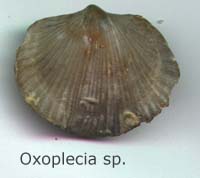
Brachiopoda main page
| Rhynchonelliformea | ||
| Brachiopoda | Orthotetida |
| Metazoa | |||
The Orthotetida are derived from the Strophomenida, and are in part included in them in older classifications. There are two suborders, the Orthotetidina and the Triplesiidina, the former with a number of families
(Early Ordovician - Late Permian)
Originally included under the Strophomenina, these unusual brachiopods appeared during the Ordovician but reached their latest culmination during the Permian period, with bizarre flattened forms like Leptodus. In this genus, the pedicle valve somewhat resembles an oyster, and this genus was even attached oyster-like by cementation of its pedicle valve to other shells. The interior of the pedicle valve bears a low median ridge, and on either side of it are grooves and ridges arranged normal to the median ridge. The brachial valve is extremely thin, and flat or slightly concave, fitting neatly over the pedicle valve. Lateral slits in the brachial valve overly the ridges of the pedicle interior, perhaps reflecting a pattern of a pair of long, convoluted brachia. The occurrence of Leptodus in Permian rocks of western Texas, but not in deposits of equivalent age nearby, shows that these forms may have been adapted to life on the flanks of Permian reefs, and were probably sensitive to variations in temperature or other environmental factors.
(Early Ordovician to Late Silurian)

Previously considered a distinct order (Tripleslida), this small group of Ordovician and Silurian brachiopods includes biconvex shells with well-developed fold and sulcus, either smooth or covered with costae. The brachial valve contains short crura and a prominent, branched cardinal process.
Triplesia ortoni is a characteristic Early Silurian fossil of the Ohio Valley.
 Brachiopoda main page |